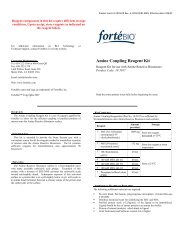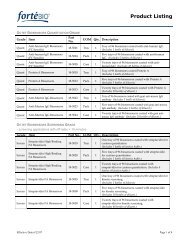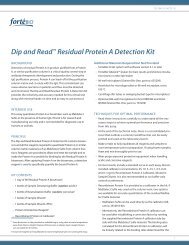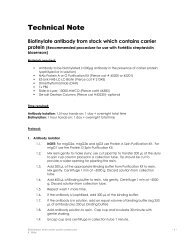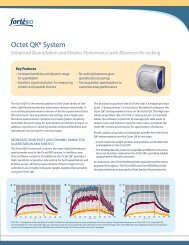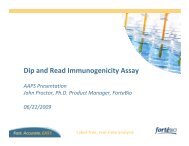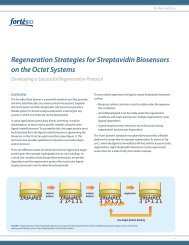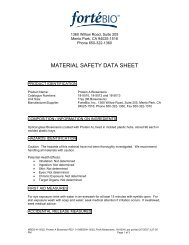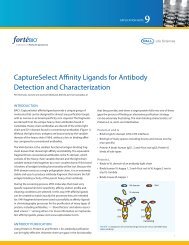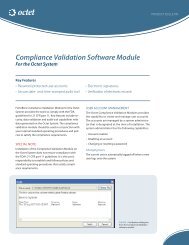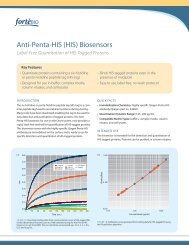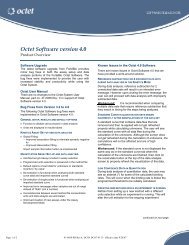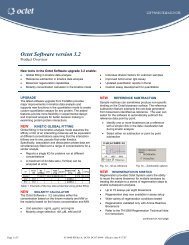Enhancing Efficiency and Economics in Process ... - ForteBio
Enhancing Efficiency and Economics in Process ... - ForteBio
Enhancing Efficiency and Economics in Process ... - ForteBio
Create successful ePaper yourself
Turn your PDF publications into a flip-book with our unique Google optimized e-Paper software.
<strong>Enhanc<strong>in</strong>g</strong> <strong>Efficiency</strong> <strong>and</strong> <strong>Economics</strong> <strong>in</strong> <strong>Process</strong> Development <strong>and</strong> Manufactur<strong>in</strong>g of Biotherapeutics<br />
Prote<strong>in</strong> Quantitation of 70 Complex Samples<br />
Octet Systems<br />
Sample <strong>and</strong><br />
<strong>in</strong>strument prep<br />
30 m<strong>in</strong><br />
Data analysis<br />
10 m<strong>in</strong><br />
60 m<strong>in</strong> total assay time<br />
40 m<strong>in</strong> operator h<strong>and</strong>s-on time<br />
Sample run time<br />
20 m<strong>in</strong><br />
HPLC<br />
Sample <strong>and</strong><br />
<strong>in</strong>strument prep<br />
4 hr<br />
Sample <strong>in</strong>jection <strong>and</strong> run time<br />
18 hr<br />
Data analysis<br />
50 m<strong>in</strong><br />
23 hr total assay time<br />
5 hr operator h<strong>and</strong>s-on time<br />
ELISA<br />
B<strong>in</strong>d capture<br />
antigen to plate<br />
Overnight (16 hr)<br />
Sample <strong>and</strong><br />
<strong>in</strong>strument prep<br />
1 hr<br />
Sample run time<br />
4 hr<br />
Data analysis<br />
30 m<strong>in</strong><br />
21.5 hr total assay time<br />
5.5 hr operator h<strong>and</strong>s-on time<br />
Figure 2: Comparison of prote<strong>in</strong> quantitation <strong>in</strong> complex matrices us<strong>in</strong>g Octet systems <strong>and</strong> alternative methods.<br />
ADVANTAGES OVER ELISA AND HPLC<br />
The pr<strong>in</strong>ciples of concentration measurement with an Octet system<br />
are similar to established immunoassays such as ELISA <strong>and</strong><br />
HPLC. However, prote<strong>in</strong> quantitation protocols on the Octet platform<br />
provide several advantages. The Octet platform monitors<br />
b<strong>in</strong>d<strong>in</strong>g of prote<strong>in</strong>s from solution to a biosensor surface <strong>in</strong> real<br />
time, without need for labels or other detection reagents. This<br />
real-time monitor<strong>in</strong>g of b<strong>in</strong>d<strong>in</strong>g <strong>in</strong>teractions enables clear<br />
discrim<strong>in</strong>ation between specific <strong>and</strong> non-specific b<strong>in</strong>d<strong>in</strong>g<br />
signals, which can shorten assay development times dramatically.<br />
Octet assays are also much faster: quantitation of a 96-well<br />
plate requires 15 – 30 m<strong>in</strong>utes, or 60 m<strong>in</strong>utes for a 384-well<br />
plate, depend<strong>in</strong>g on the <strong>in</strong>strument model. Figure 2 provides a<br />
comparison of analysis times. Analysis of 70 samples on an Octet<br />
RED96 system requires as little as 55 m<strong>in</strong>utes <strong>in</strong>clud<strong>in</strong>g operator<br />
h<strong>and</strong>s-on time, whereas ELISA or HPLC assays require at least 22<br />
hours <strong>in</strong>clud<strong>in</strong>g several hours of analyst <strong>in</strong>volvement. Samples<br />
run on Octet systems are also recoverable, so that researchers<br />
may save <strong>and</strong> reuse precious samples for other experiments. In<br />
addition, Octet assays are not affected by absorption <strong>in</strong>terferences<br />
<strong>in</strong> colored samples or by light scatter<strong>in</strong>g with turbid samples,<br />
enabl<strong>in</strong>g measurement of analyte concentration <strong>in</strong> crude matrices<br />
such as cell culture supernatant, cell lysate <strong>and</strong> serum. Octet<br />
concentration assays are complemented by the platform’s ability<br />
to measure functional activity. For example, titer for a monoclonal<br />
antibody (mAb) can be determ<strong>in</strong>ed us<strong>in</strong>g biosensors coated<br />
with Prote<strong>in</strong> A, while the functional activity of the mAb can be<br />
assessed <strong>in</strong> a second assay step <strong>in</strong>volv<strong>in</strong>g b<strong>in</strong>d<strong>in</strong>g to its specific<br />
antigen. In contrast, HPLC <strong>and</strong> A280 spectroscopy can determ<strong>in</strong>e<br />
only the total prote<strong>in</strong> concentration of a sample, <strong>and</strong> separate<br />
assays must be used to measure biological activity.<br />
BIO-LAYER INTERFEROMETRY TECHNOLOGY (BLI)<br />
BLI technology monitors <strong>and</strong> analyzes the <strong>in</strong>terference pattern<br />
generated from the reflection of white light from two different<br />
surfaces: a layer of immobilized prote<strong>in</strong> on the biosensor tip <strong>and</strong> an<br />
<strong>in</strong>ternal reference layer (Figure 3). Any <strong>in</strong>crease or decrease <strong>in</strong> the<br />
number of b<strong>in</strong>d<strong>in</strong>g molecules on the biosensor surface produces<br />
a change <strong>in</strong> optical thickness that causes a shift <strong>in</strong> the <strong>in</strong>terference<br />
2




